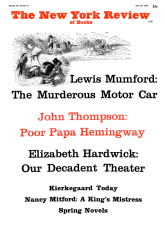In response to:
The Strange Trial of the Rosenbergs from the February 3, 1966 issue
To the Editors:
Professor Packer, in his review of Invitation to an Inquest [NYR, February 3] would appear to want examiners of questioned documents to work blind-folded and in a vacuum. He says Elizabeth McCarthy’s conclusion that the photostat of the hotel registration card of Harry Gold dated June 3, 1945, was a forgery is “suspect” because we are not told whether she was forewarned as to which of two documents was the one suspected of being a forgery. He refers us to “a similar conclusion by the same expert” by a footnote reference to pages 31-32 of his book Ex-Communist Witnesses: Four Studies in Fact Finding (1962). The “similar conclusion” there has to do with Miss McCarthy’s expert opinion as to the likelihood of forgery in the Hiss case given in affidavit form on the late Chester T. Lane’s Motion for a New Trial of that case filed in January 1952. On that motion Professor Packer would seem to require an even stricter rule for questioned documents examiners. Apparently Miss McCarthy not only should not have been told which were the suspected documents; she should also not have been “alerted to the possibility of forgery”!
A questioned documents examiner’s business is to detect forgeries; this is the reason they are hired. Hence, they are “alerted to the possibility of forgery” the minute they are retained by a client. And how is an expert to come to any conclusion as to whether a particular document is a forgery unless he (or she) is given a known standard to compare with the suspected document? No one can tell whether a signature or a typed document is a forgery unless they have a sample of the genuine article which is suspected of having been forged. This would seem to be basic.
I do not wish to reargue any aspect of the Hiss case in these columns, but in view of Professor Packer’s now repeated implication that Mr. Lane did not—where that was feasible—submit blind samples to expert scrutiny, I would like to point out to any who may have been intrigued enough to look up his reference to his chapter on the Hiss-Chambers case, the sentence in which he there, too, gives a misleading impression of Mr. Lane’s work on the Motion for a New Trial. Professor Packer says (p. 32):
If only Mr. Lane had obtained a completely “blind” expert opinion on the samples from 230099 and the Tytell machine, we would have a benchmark for assessing what weight, if any, to assign to the fact that the examination of the crucial papers (the Baltimore Documents and the Hiss Standards) was carried on by experts who were alive to the possibility of forgery, and whose judgment must have been affected by their knowledge.
Having easy access to all the papers Mr. Lane filed on his Motion for a New Trial (I was his secretary and worked with him through every aspect of his agonizing investigation in the case), I went back to read those papers to refresh my memory and found what I thought I would find. In Mr. Lane’s Supplemental Affidavit in Support of the Motion, filed March 12, 1952, he said:
Mrs. Ehrlich’s function, as I first consulted her, was to give me an informed judgment on the success of my experiment in duplicating the typing product of Woodstock N230099. I gave her samples of typing from the two machines [Mrs. Ehrlich’s affidavit appended to the original motion states clearly: “These samples were not marked or separated in any way to indicate which machine had been used to type any individual document”] and she successfully distinguished them, though only on the basis of a few minor remaining discrepancies. I was not surprised that she could tell them apart; what startled me, in the discussion in which she reported her results, was that she had concluded that the samples I had made on N230099 were the ones on Tytell’s fabricated machine. When I corrected her, she assured me that the only possible explanation was that N230099, as well as the machine Tytell had made for me, must be a forgery—and not as carefully constructed a forgery as Tytell’s. She said there was no other way of accounting for certain peculiarities of the typing from N230099 which she could observe by photomicrography.
Professor Packer does not mention this surprising development; but here was an expert not forewarned as to which were the forged specimens, and she picked the specimens from the machine which had been the exhibit at the Hiss trial and had been accepted by both the Government and the defense as the machine which had typed the Baltimore Documents. This confirmed Mr. Lane’s earlier suspicion as to the authenticity of that typewriter and led to an examination of it by Dr. Daniel P. Norman, a metallurgical expert, and to his affidavits on the Motion for a New Trial regarding “positive signs of [its] having been deliberately altered.”
Margaret L. Burton
Brooklyn, New York
This Issue
April 28, 1966



